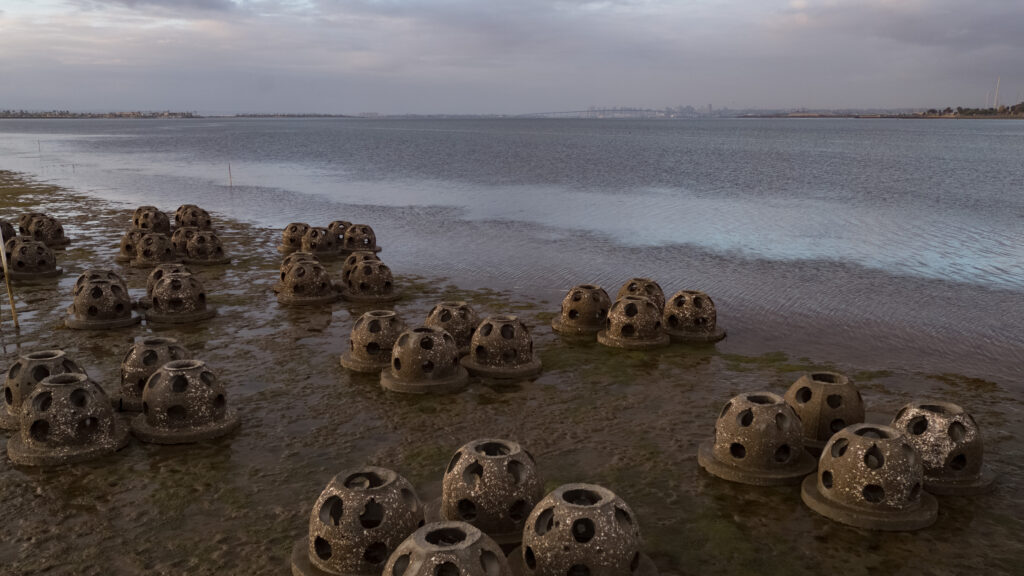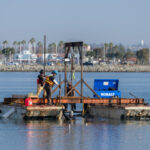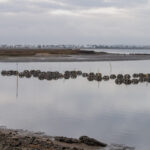The Port of San Diego, in partnership with the California State Coastal Conservancy and U.S. Fish & Wildlife Service, has begun installation of the South Bay Native Oyster Living Shoreline Project adjacent to the Chula Vista Wildlife Refuge. This project has been years in the making and is the latest of several Port projects to protect the shoreline from impacts related to rising sea levels and to increase the biodiversity of San Diego Bay by creating new marine habitats.
The project’s total cost is approximately $960,000 and is fully funded via grants from the U.S. Fish and Wildlife Service and Builders Initiative. The cost covers the fabrication, installation, and long-term monitoring of the project.
“The Port of San Diego is proactively and continuously planning for and implementing various strategies to reduce the impacts of future sea level rise,” said Chairman Michael Zucchet, Port of San Diego Board of Port Commissioners. “We are grateful to the U.S. Fish and Wildlife Service, California State Coastal Conservancy and Builders Initiative for their support of this important project that will strengthen coastal resiliency along our waterfront while also helping to protect and enhance the diverse ecosystems in and around San Diego Bay.”
Living shorelines rely on natural elements, such as plants or, in this case, oysters, to stabilize shorelines in place of the traditional hard armoring – such as rip rap revetment and sea walls that we currently see prevalent around the bay. Living shorelines are an excellent resiliency strategy in the face of sea level rise due to their ability to naturally adapt and grow over time.

This project is utilizing a modular approach under which constructed reef ball elements are being placed in a series of six arrays. Each reef array includes 15 reef groups composed of four reef ball elements made of baycrete (concrete mixed with local sand and oyster shell aggregate) placed in a square pattern for a total of 360 reef ball elements and 90 reef groups. The elements will be placed at specific elevations to optimize recruitment of native oysters.
Each reef array is roughly 88 feet long by 45 feet wide to accommodate the 15 reef groups with 14-20 feet of spacing between each reef group. While the total area of the project spans approximately 29,700 sf (0.68 acre) of intertidal shoreline, the total “footprint” of the reef ball elements would be substantially lower at 5,760 sq ft (0.13 acre).
The project’s objective is to demonstrate the ability to attract and establish native oyster populations that create structurally complex “reef” habitats for fish, birds, invertebrates, and aquatic plants. The project is also expected to improve local water quality via oyster water filtration and settling of sediments, as well as increase wetland connectivity to intertidal and subtidal lands.
After installation is complete, the pilot project and the adjacent shoreline will be monitored and assessed for five years to study the amount of growth of native oysters on the reef elements; learn about the presence and/or absence of non-native species on the reef elements; learn how the reef impacts or enhances local species richness of fish, birds and mobile invertebrates within the project footprint; and determine the ability of the reef elements to catalyze sediment accretion or reduce erosion of sediment shoreward of the project.
The project is the result of over five years of collaboration across a project team representing state and federal agencies, academia, regional government, and the non-profit sector, including Environmental Science Associates who were involved in the design process. If successful, the reef will be permanent. Project partners share an interest in addressing shoreline protection, fishery populations and health, and climate change in San Diego Bay through scientifically supported alternatives to standard shoreline armoring.
“The State of California is investing in the health and resilience of its shorelines to protect our communities and economies, while supporting the biodiversity of our coastal habitats,” said Amy Hutzel, Executive Officer, California State Coastal Conservancy. “This project demonstrates the potential of nature-based solutions to help one of California’s most iconic and vibrant waterfronts keep pace with rising seas.”
“The Carlsbad Fish and Wildlife Office’s Coastal Program is excited to be partnering with the Port of San Diego and California State Coastal Conservancy to protect and enhance San Diego Bay’s shoreline, which is critical to wildlife and the coastal community,” said Scott Sobiech, Carlsbad Fish and Wildlife Office Field Supervisor. “National Coastal Wetlands Conservation grants issued by the U.S. Fish and Wildlife Service’s Sport Fish Restoration Fund are made available through recreational fishing taxes, so we in turn want to thank our angling and boating partners for their contributions to wetlands conservation.”
“Larison Contracting Corp is pleased to be a part of the team to construct the Native Oyster Living Shoreline,” said Clint Larison, vice-president of Larison Contracting Corp. “We are enjoying working with the Port of San Diego and City of Chula Vista on this exciting project.”









